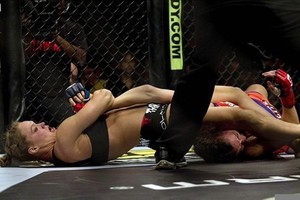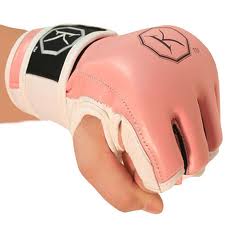Three-minute rounds for female boxing in New York State

When Susan Reno (1-3-2) and Paola “La Loba” Ortiz (0-5-1) step into the ring at Brooklyn’s storied Masonic Temple on May 15th, they’ll be doing something no other female fighters in a sanctioned New York State bout have done before, they’ll be contesting their battle using the three-minutes per round they’re trained to fight, not the two-minute versions they’ve been consigned to.
A smattering of states quietly sanctioned three-minute rounds over the years. In California, current IBO heavyweight champion Sonya Lamonakis fought six hard three-minute rounds in 2013 against the current WBC champion Martha Salazar. While a surprise to Lamonakis, who’d expected the bout to be fought at two-minutes per round, in a recent conversation as she readies for her championship battle against Gwendolyn O’Neil in St. Maartin on May 30th, she said, “Well I’m all for it. I did it already for six rounds in California. I think it may even make the women more elite.”
Of all the states, however, Nevada has led the way in sanctioning three-minute round female bouts. Most notably, beginning in 2007, the Boxing Commission worked with pound-for-pound women’s boxing great Layla McCarter to not only sanction longer rounds, but twelve round championship bouts. In the late 1970s, there were also more than a few boxing matches that were contested at three minutes per round, and even a couple of fifteen round championship bouts, but otherwise, women’s boxing has long been relegated to near on amateur status when it comes to professional fighting: two-minutes per round with a maximum of ten rounds for a championship fight.
The issue of three-minute rounds has been a crucible for women’s boxing, and lies at the heart of legitimizing the hard work and effort that goes into professional boxing contests between female fighters including such matters as television time and the pay checks female boxers receive, which are paltry compared to their male counterparts. The “joke” is that women are told they receive less pay because they only fight two-minute rounds! It is also part of a continuing argument on issues of female stamina and even whether the monthly menstrual cycle affects the ability of women to fight longer. The latter was part of the argument used by the World Boxing Council (WBC) sanctioning body, which in supporting championship belts for women, has also waded into the fray by stating they would only sanction two-minute round, ten round bouts for women.
Alicia “Slick” Ashley, a former WBC champion has been outspoken on the three-minute round issues. In her experience, she’s, “felt the pressure to perform quicker because of the two-minute time limit which of course is better suited for volume punchers but as a boxer I’ve learned to adjust and started my fights off faster.”
She also argues that, “MMA had the foresight to have women on an even footing immediately is something that powers behind boxing never had,” and goes on to say, “How can you say women cannot box three-minute rounds when MMA proves that women can fight five-minute rounds? Hopefully MMA will help open the eyes of the boxing world. We as female fighters can only keep pushing for change or at least the option of fighting for three minutes.”
When asked about New York State’s decision to sanction three-minute rounds, she said, “I’m very happy that NYS had the option of women fighting three-minute rounds if both parties agree. The fact that the Commission understands that women can and will fight longer if given the opportunity is a step in the right direction to competition and hopefully pay equality.”
Boxing trainers also agree that holding women to two-minute rounds is arbitrary at best. Veteran Lennox Blackmoore who has been training female champions since the late 1990s including Jill “the Zion Lion” Mathews the first woman to win a New York Daily News Golden Gloves contest in 1996 said, “I think that’s great. When a woman trains, she trains three minutes a round like anybody else. I don’t see why she shouldn’t fight that way. There are a lot of good women boxers, and it’ll show people what they can do. Jill Mathews fought ten rounds for a championship belt, but it could have three-minute rounds too, she had the experience and the endurance to do that because she trained that way.”
Grant Seligson, a trainer at Gleason’s Gym who works with an array of female fighters from White Collar boxers on through competitive fighters agrees. “Women’s endurance is not only as good as a man’s, but is often better. Besides it’s women competing against women of the same weight, so why shouldn’t it be three minutes a round.”
Given the momentum of women’s MMA with its five-minute rounds–the same for male and female fighters–, and the obvious appeal female boxers continue to have with audiences even given the virtual media blackout in the United States, the fact that the NYS Boxing Commission has opened things up is something to be applauded.
To learn more about how this all came about, boxer Susan Reno agreed to take time from her busy training schedule to detail her experiences with Girlboxing readers. We all owe a lot to the New York State Boxing Commission’s, Melvina Lathan and David Berlin, along with Susan Reno, Paola Ortiz and Uprising Promotions for what will be an historic event on May 15th.

Paola “La Loba” Ortiz (l) and Susan Reno (r) will fight the first sanctioned 3-minute per round female bout in New York State on May 15, 2015 at Brooklyn Masonic Temple. Credit: Susan Reno
- In the world of women’s boxing, 3-minute rounds have been the “Holy Grail”? How in the world did you convince the NYS Boxing Commission to sanction 3-minute rounds for your upcoming six-rounder with Paola Ortiz?
There was very little convincing! It just took time. I feel New York has seen female boxers demonstrate time and time again, that we belong in the ring and know what we are doing. In 2013 Vanessa Greco and I fought a fast-paced, six round draw. After witnessing our action packed bout, NYSAC Chairperson, Melvina Lathan and long-time NY Promoter Bob Duffy both agreed that it was time for women to fight three-minute rounds. Not only are we capable, but we are entertaining and the longer rounds could help avoid draws.
The opportunity did not present itself until this year (I had only fought in California in 2014). In a conversation with NYSAC Executive Director, David Berlin, he wondered out loud “why don’t women fight three-minute rounds?” I jumped on that thought and said, “I’ll do it!” He too, recognized women have the skill, stamina and focus to fight the same amount of time as the men. His response was “let’s make history!”
I was unaware that there had not been a female boxing match consisting of three-minute rounds in New York. I knew that both Melissa Hernandez and Belinda Laracuente had both fought Layla McCarter in Vegas and their bouts were three-minute rounds. I definitely wanted to seize the opportunity and follow in their footsteps.
My team, Ronson Frank/Uprising Promotions and Paola Ortiz’s camp all agreed to the three-minute rounds and the Commission approved and as the saying goes, “the rest is history.”
- WBC has come out to say they would not sanction 3-minute round female boxing championships citing what many have considered to be specious “science.” What do you feel the response should be from female fighters?
I respect the WBC’s decision to not sanction three-minute rounds. They run a business and every business has to protect itself. I love your phrase “specious science” Malissa! There is no shortage of it on the internet! I can understand a company’s struggle with “inconclusive” or “cloudy” data. Maybe when the question regarding three-minute rounds came up, the answers where not ones they were ready for. From a business standpoint the question is to invest (sanction 3 minute rounds) or not invest? While I respect their decision, I don’t have to agree with it. I feel female fighter’s response should be to invest in our ourselves. Take the best possible care of ourselves physically and mentally and get in the ring and prove them wrong!
- Every woman I know who boxes (myself included) trains and spars for three-minute rounds, but when it comes to fights, has had to adjust to two-minute rounds competitively. How does that affect your fight plan?
I feel the adjustment from training three-minute rounds to fighting two-minute rounds applies unnecessary pressure to “get the job done.” I know many women who can pace out and box the two-minute rounds. World Champion Alicia Ashley does it beautifully and consistently. But many times, the two minutes can create more of a battle than a boxing match. While this can be exciting and fan friendly, it can be difficult to set traps for your opponent and catch them before the bell rings. I imagine the short rounds can make judging difficult as well.
- With a three-minute round fight, what adjustments to your fighting style do you feel you will make–or, is this the “natural” way to fight, since it’s the way you train, and the adjustments have come in the two-minute round battles?
I have proven time and time again that I can fight. Now it’s time to box and I feel I will be more comfortable knowing I have more than 120 seconds at a time to hunt, trap and catch my prey.
- Now that NY State has sanctified a three-minute fight, what do you think the future will hold?
I feel this fight will open the door to all of the talented and dedicated female fighters in New York as well as those (such as my opponent Paola Ortiz) who are hungry to prove our worth in the business of boxing. Boxing is a business. I understand that. One excuse women are given in regard to our fight purse, is that we fight shorter rounds. Some promoters say that since we fight less time, that equals less pay. So I say, let’s fight the same amount of time and take away that rationale. I recognize that what I can do in boxing right now, can benefit women in the future. It is my hope that in the near future, professional female boxers can get on TV, gain recognition and get paid for their work same as professional male boxers. I believe fighting three-minute rounds will help level the playing field and create equal business opportunities.
 I’ve been seeing Heather three mornings a week at Gleason’s Gym since before the move to Water Street. We generally roll into the gym about the same time–between 6:30 and 7:00 AM, her to a roster of clients of varying skills and abilities she trains in the sweet science, and me to my work with trainer Lennox Blackmoore. By 9:00 AM, Heather has usually started her own training and if she’s readying for a fight adds yet more hours for “camp” while still keeping up with her clients well into the evening, and her obligations to her daughter–not to mention selling tickets to her fights, giving interviews, meeting with sponsors and potential sponsors, and so on.
I’ve been seeing Heather three mornings a week at Gleason’s Gym since before the move to Water Street. We generally roll into the gym about the same time–between 6:30 and 7:00 AM, her to a roster of clients of varying skills and abilities she trains in the sweet science, and me to my work with trainer Lennox Blackmoore. By 9:00 AM, Heather has usually started her own training and if she’s readying for a fight adds yet more hours for “camp” while still keeping up with her clients well into the evening, and her obligations to her daughter–not to mention selling tickets to her fights, giving interviews, meeting with sponsors and potential sponsors, and so on. I’ll leave it to the critics and trolls on Twitter to discuss whether the fight was really “boring” or not.
I’ll leave it to the critics and trolls on Twitter to discuss whether the fight was really “boring” or not.









